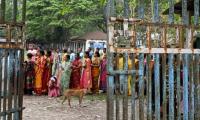The Indus Basin provides us with a total annual flow of 145MAF (million acre feet). The total annual flow has four major components: Indus (including Kabul) 89MAF; Jhelum 22MAF, Chenab 25MAF and eastern rivers 9MAF. Water demand: Of the total annual flow, 104MAF is diverted for irrigation. For domestic use, the international standard is 35 gallons per capita per day, and based on a population of 207 million (census 2017), our annual domestic water demand stands at 12MAF. For industrial use, our current water demand stands at around 18MAF. The total annual flow exceeds the aggregate water demand. In other words, we are not water scarce.
Identifying the problem: Three major losses: water loss in canals, 24MAF, loss of water through water-courses, 21MAF and field losses, 33MAF. As a consequence, the total water loss is 77MAF.
Dams: Storage of water in dams is primarily to buffer supply variability. Pakistan’s ‘inter-annual variability is relatively low; coefficient of variation 0.13 (according to Dr William Young, lead water resources management specialist with the World Bank’s Global Water Practice).’ Fortunately, our supply variability is low because of the ‘buffering by glaciers’.
A by-product of storing water in dams is the generation of electricity. But this is an expensive mode of generating electricity, particularly when much cheaper alternatives – in the form of renewable – are available.
Cost of electricity: Lighting a 100 Watt bulb from Neelum-Jhelum at a cost of Rs100,000; one Watt solar Rs50. In short, solar power solutions are up to 20 times cheaper than hydropower (according to Dr Hassan Abbas, an expert in hydrology and water resources).
Economic viability of the Bhasha Dam: The dam is expected to cost $14 billion with 6MAF of live storage. As per Dr Young’s projection, the Bhasha Dam will produce extra production equivalent to $500 million per year. That means ‘30-year pay-back considering only irrigation’. That certainly is a long pay-back. In order to crowdfund $14 billion, each and every Pakistani family would have to contribute Rs60,000 (when 39 percent of Pakistanis live in multidimensional poverty).
Fact: No ‘significant changes in river flows are projected before 2050’.
Identifying another problem: Pakistan produces agricultural products worth $60 billion by using 104MAF of water (the world around us produces the same amount with half that much water). Pakistani farmers can cut their demand for water by 50 percent by using existing technology and effective water management (bubbler, sprinkler or drip irrigation).
Solutions: Efficient allocation, improving service-delivery and demand-management.
Conclusion: Our problem is water-management and not water-scarcity. We are currently focusing on water-scarcity – which is wrong. We should be focusing on water management. Dams are awfully expensive to build – the Bhasha will store a mere 6MAF and cost a colossal $14 billion. Dams belong to the last century. We don’t use piston steam engines any more, do we? Dams were built by countries with high-supply variability. Pakistan has low-supply variability.
The writer is a columnist based in Islamabad.
Email: farrukh15@hotmail.com Twitter: @saleemfarrukh
A woman walks past a building of the International Monetary Fund. — AFP/FileThe annual and spring meetings of the...
Late Benazir Bhutto's daughter Asifa Bhutto Zardari addresses the Christian community in Bihar Colony on January 23,...
Representational image. — PexelsWater is an important scarce natural resource that is required for several everyday...
Pakistani employees of online marketplace company Kaymu at work in Karachi. — AFP/FileThe true spirit of development...
India uses Afghanistan as a backstage area to carry out terrorist attacks against Pakistan
Another report by the Pakistan Institute of Peace Studies states that 78 per cent of attacks have been carried out by...







